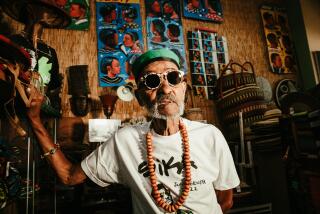Titian painted in a new biography
Titian
His Life
Sheila Hale
Harper Collins: 832 pp., $39.99
This is a long book about a long life, a large volume about a large talent. Titian, its titular subject, was the most celebrated painter of his time. He died in his beloved Venice, Italy, on Aug. 27, 1576. The death certificate listed the cause of his demise as fever and age as 103.
Like so much else about the artist, however, the date of his birth remains uncertain; it’s more likely he died in his late 80s. Even his name is subject to variation. He signed documents and paintings with “various spellings of his Christian name: Titian, Ticiano, or the Latinized Ticianus or Titianus.”
The name by which many scholars know him, Tiziano Vecellio, signals the village close to Venice where he was born (most likely between 1488 and 1490). As his biographer reports, “Venice in 1500 was the wealthiest, most glamorous, most sophisticated, most cosmopolitan, most admired — and most hated — metropolis in Europe, centre of the only empire since ancient Rome to be named after a city rather than a dynasty.”
As for his looks, there remain a few self-portraits done in elder age — thin-faced, sharp-nosed and balding — and a few renderings by artists such as Veronese and Bassano; there’s a swatch of hagiographic discourse from his friend Pietro Aretino, whom he painted often. But there have been no full-length biographies since 1877. Until now.
Sheila Hale is the author of guidebooks of Florence and Tuscany (1983), Venice (1984) and an architectural history of Verona (1991). A trustee of the Venice in Peril charity, she wrote “The Man Who Lost His Language,” about her late husband, John Hale, to whose memory this book is dedicated and with whom she worked on “Renaissance Venice” and “The Civilization of Europe in the Renaissance.”
What she has not done before is write principally as an art critic, and this is not the sort of book to read if you admire, say, Simon Schama on “Rembrandt’s Eyes” or Robert Hughes on “Goya.” We learn about Titian’s business dealings, his letters to and from his patrons, his arguments with and aspirations for his children. We read about the number of gold chains and medals he wore. But we do not learn much about the art, except in terms of the nature of the pigment deployed, the size of the project and commission, and the time it took to finish.
Yet Hale’s discussion is nothing if not comprehensive. Name a political leader or potentate of the era, a treaty or a treatise or a tax collectors’ log, a distant war or nearby plague, a pope or architect or courtesan — they will be included here. Charles V and Phillip II, Titian’s principal patrons, receive their own extended treatment. There are lengthy disquisitions on the world the painter inhabited. But he remains a somehow shadowy presence. Indeed, it takes until Page 99 before we read the following: “The relevant entries in the confraternity account book for the next months are the earliest surviving records in which Titian’s name appears.”
The bulk of his recorded speech and surviving letters deal with minutiae of status and money. He was unfailingly engaged in the size and schedule of his payments, the nature of his commissions, the question of a priesthood he sought for his son Pomponio. Yet he was discreet about his private life and not verbally expressive.
Unlike the obsessive letter-writer and playwright Aretino (whose hand can be discerned in Titian’s more flowery epistles), Titian was never confessional. We read at length about the history of the trips he took and houses he occupied. We learn little about his second wife or the mother of his illegitimate daughter. He may have produced the first great images of female flesh, but we do not know, for instance, if he made love to his models. “Titian was not the first artist to paint naked women, but he was the first to use live models, and to paint them lying down.”
Hale inclines to hyperbole. Of a description of the master’s working methods by Palma Giovane, who joined Titian’s workshop, she writes: “It is the most vivid and revealing description of a great painter at work in the literature of art.” Well, perhaps. His influence on artists such as Rubens, Velázquez and Rembrandt cannot be overstated, but his own writings on the artistic process (unlike Michelangelo’s) are next to nonexistent.
As his biographer observes, “His genius transcends time and place, but he could not have painted as he did in another time or place.” The “time and place” here are scrupulously rendered, but the transcendent “genius” remains—for this reader— opaque. “Titian” is both exhaustive and exhausting: better, perhaps, as a reference text than one that brings the painter back to life.
Delbanco is the Robert Frost distinguished university professor at the University of Michigan. His most recent book is “Lastingness: The Art of Old Age.”
More to Read
Sign up for our Book Club newsletter
Get the latest news, events and more from the Los Angeles Times Book Club, and help us get L.A. reading and talking.
You may occasionally receive promotional content from the Los Angeles Times.







